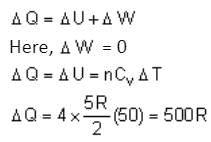JEE Exam > JEE Questions > The amount of heat needed to raise the temper...
Start Learning for Free
The amount of heat needed to raise the temperature of 4 moles of a rigid diatomic gas from 0°C to 50°C when no work is done is ______. (R is the universal gas constant.
- a)750 R
- b)175 R
- c)500 R
- d)250 R
Correct answer is option 'C'. Can you explain this answer?
Verified Answer
The amount of heat needed to raise the temperature of 4 moles of a rig...


|
Explore Courses for JEE exam
|

|
Similar JEE Doubts
The amount of heat needed to raise the temperature of 4 moles of a rigid diatomic gas from 0°C to 50°C when no work is done is ______. (R is the universal gas constant.a)750 Rb)175 Rc)500 Rd)250 RCorrect answer is option 'C'. Can you explain this answer?
Question Description
The amount of heat needed to raise the temperature of 4 moles of a rigid diatomic gas from 0°C to 50°C when no work is done is ______. (R is the universal gas constant.a)750 Rb)175 Rc)500 Rd)250 RCorrect answer is option 'C'. Can you explain this answer? for JEE 2025 is part of JEE preparation. The Question and answers have been prepared according to the JEE exam syllabus. Information about The amount of heat needed to raise the temperature of 4 moles of a rigid diatomic gas from 0°C to 50°C when no work is done is ______. (R is the universal gas constant.a)750 Rb)175 Rc)500 Rd)250 RCorrect answer is option 'C'. Can you explain this answer? covers all topics & solutions for JEE 2025 Exam. Find important definitions, questions, meanings, examples, exercises and tests below for The amount of heat needed to raise the temperature of 4 moles of a rigid diatomic gas from 0°C to 50°C when no work is done is ______. (R is the universal gas constant.a)750 Rb)175 Rc)500 Rd)250 RCorrect answer is option 'C'. Can you explain this answer?.
The amount of heat needed to raise the temperature of 4 moles of a rigid diatomic gas from 0°C to 50°C when no work is done is ______. (R is the universal gas constant.a)750 Rb)175 Rc)500 Rd)250 RCorrect answer is option 'C'. Can you explain this answer? for JEE 2025 is part of JEE preparation. The Question and answers have been prepared according to the JEE exam syllabus. Information about The amount of heat needed to raise the temperature of 4 moles of a rigid diatomic gas from 0°C to 50°C when no work is done is ______. (R is the universal gas constant.a)750 Rb)175 Rc)500 Rd)250 RCorrect answer is option 'C'. Can you explain this answer? covers all topics & solutions for JEE 2025 Exam. Find important definitions, questions, meanings, examples, exercises and tests below for The amount of heat needed to raise the temperature of 4 moles of a rigid diatomic gas from 0°C to 50°C when no work is done is ______. (R is the universal gas constant.a)750 Rb)175 Rc)500 Rd)250 RCorrect answer is option 'C'. Can you explain this answer?.
Solutions for The amount of heat needed to raise the temperature of 4 moles of a rigid diatomic gas from 0°C to 50°C when no work is done is ______. (R is the universal gas constant.a)750 Rb)175 Rc)500 Rd)250 RCorrect answer is option 'C'. Can you explain this answer? in English & in Hindi are available as part of our courses for JEE.
Download more important topics, notes, lectures and mock test series for JEE Exam by signing up for free.
Here you can find the meaning of The amount of heat needed to raise the temperature of 4 moles of a rigid diatomic gas from 0°C to 50°C when no work is done is ______. (R is the universal gas constant.a)750 Rb)175 Rc)500 Rd)250 RCorrect answer is option 'C'. Can you explain this answer? defined & explained in the simplest way possible. Besides giving the explanation of
The amount of heat needed to raise the temperature of 4 moles of a rigid diatomic gas from 0°C to 50°C when no work is done is ______. (R is the universal gas constant.a)750 Rb)175 Rc)500 Rd)250 RCorrect answer is option 'C'. Can you explain this answer?, a detailed solution for The amount of heat needed to raise the temperature of 4 moles of a rigid diatomic gas from 0°C to 50°C when no work is done is ______. (R is the universal gas constant.a)750 Rb)175 Rc)500 Rd)250 RCorrect answer is option 'C'. Can you explain this answer? has been provided alongside types of The amount of heat needed to raise the temperature of 4 moles of a rigid diatomic gas from 0°C to 50°C when no work is done is ______. (R is the universal gas constant.a)750 Rb)175 Rc)500 Rd)250 RCorrect answer is option 'C'. Can you explain this answer? theory, EduRev gives you an
ample number of questions to practice The amount of heat needed to raise the temperature of 4 moles of a rigid diatomic gas from 0°C to 50°C when no work is done is ______. (R is the universal gas constant.a)750 Rb)175 Rc)500 Rd)250 RCorrect answer is option 'C'. Can you explain this answer? tests, examples and also practice JEE tests.

|
Explore Courses for JEE exam
|

|
Signup for Free!
Signup to see your scores go up within 7 days! Learn & Practice with 1000+ FREE Notes, Videos & Tests.
























